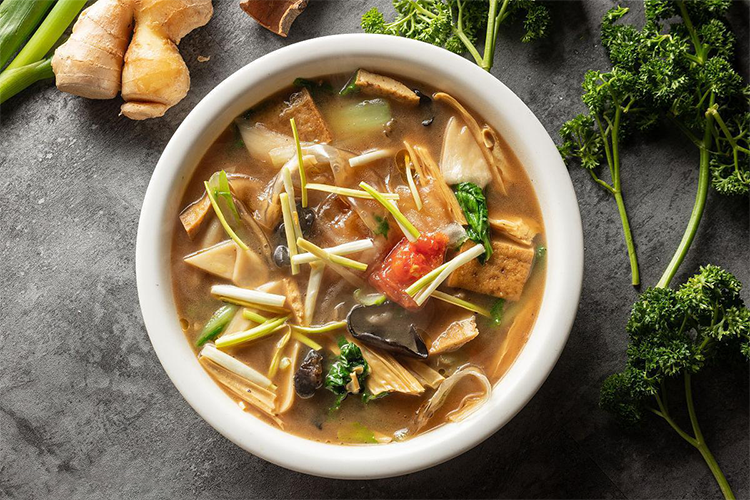A Steaming Bowl of Ningxia Comfort: Discovering Hui Xiaochi
When the northwestern winds sweep across the Ningxia plain, a steaming bowl of Hui Xiaochi—a hearty Ningxia stew snack—offers the most comforting relief. Simple rather than refined, this local specialty combines robust ingredients, a rich broth, and a homely spirit that reflects Ningxia cuisine. For visitors, tasting an authentic bowl is both a culinary delight and a cultural immersion into this Silk Road crossroads.
1 Origin and History: A Fusion Born of Hospitality
Hui Xiaochi’s history is tied to Ningxia’s role as a Silk Road node and its multiethnic communities. With caravans and merchants passing through, beef and mutton became staple proteins. Locals developed a practical way to make a warming, quick meal in winter by stewing available ingredients—fresh mutton or beef, local potatoes, handmade noodles or jelly, and more—in a single pot. This efficient “mixed stew” method brought together diverse flavors into one harmonious broth.
The name Hui Xiaochi literally means “stew snack,” and its other common name—Hui Jiaban Wanzi or “Hui jiaban and meatball stew”—highlights its two stars: the jiaban (stuffed egg pancake) and meatballs. From humble home kitchens, this dish grew into a festive and hospitable specialty, served at celebrations and to honored guests, embodying Ningxia people’s warmth and straightforward generosity.
2 Key Ingredients: Local Produce from the North
A great Hui Xiaochi depends on generous, authentic ingredients:
- Soul of the broth: locally raised Tan sheep or yellow cattle (beef). Tan sheep meat is tender with a mild aroma and deeply enriches the soup’s flavor.
- Signature snacks in the stew: the jiaban (also called jiasha or stuffed egg pancake) and meatballs.
- Jiaban (jiasha): thin egg crepes filled with seasoned minced meat, cut into diamond or rectangular pieces and fried until set. The outer layer is soft yet slightly chewy, with a juicy filling—an essential textural contrast.
- Meatballs: made from minced beef or mutton, fried until golden, then simmered in the soup to soak up the broth—soft and richly flavored.
- Abundant vegetables: potato chunks, spinach, Chinese chives (jiucai), wood ear mushrooms, daylily buds, tofu, and liangfen (cold mung-bean jelly). These add color, nutrition, and absorb the meat broth’s essence—potatoes become silky, liangfen adds a pleasant slippery texture, and leafy greens cut through the richness.

3 How It’s Made: Layering Flavors in One Pot
Although the method appears rustic, it follows a clear sequence that controls heat and timing.
First, prepare separately: fry the jiaban and meatballs until golden, cut potatoes into chunks, and wash and slice vegetables. Next, simmer a rich stock from beef or mutton bones. The art of “hui” (stewing) is about order: add hard-to-cook items like potatoes and tofu to the boiling stock first. Once they soften, add jiaban, meatballs, and quick-cooking greens such as spinach and chives. Season simply with salt and white pepper, and finish with a light cornstarch slurry to slightly thicken the broth so it clings to each ingredient. In the boiling pot, the flavors meld, producing a substantial, savory Hui Xiaochi.
4 Taste, Texture, and How to Eat It: A Soup-and-Dish Experience
A served bowl immediately pleases the eye with its variety and color. Stirring up the bowl releases an inviting aroma. For the best experience, scoop together some broth, a meatball, a piece of jiaban, and vegetables in one spoonful.
Flavor and texture layers are apparent: the broth is savory and rich with beef or mutton notes; the egg crepe is silky with a meaty center; meatballs become tender and soaked with broth; potatoes melt in the mouth; and spinach and chives refresh and balance the dish’s richness. The result is a complex, comforting taste—salty, savory, and warming.
Hui Xiaochi is naturally a shared dish. It pairs perfectly with Ningxia rice or local steamed breads such as huajuan or mantou, which are often dipped into the broth so nothing is wasted.

5 Where to Try It and Traveler Tips
- Best time to eat: Hui Xiaochi is especially satisfying in autumn and winter. On chilly days in Ningxia, a hot bowl quickly warms body and spirit.
- Where to find authentic versions: Look for Hui Xiaochi in Yinchuan, Wuzhong, Zhongwei, and other Ningxia cities—particularly at long-established restaurants and family-run eateries favored by locals.
- Ordering tips: Portions are usually large and suitable for 2–3 people to share. If traveling with a group, add other northwest specialties such as hand-pulled lamb or lamb offal stew to build a hearty regional feast.
- Dietary preferences: If you dislike mutton aroma, ask whether the restaurant can substitute beef—many can accommodate this.
6 Easy Home Version: Recreate the Comfort at Home
Even away from Ningxia, you can make a simplified Hui Xiaochi at home.
- Quick recipe:
- Ingredients: store-bought beef or pork meatballs, thin tofu skin or dried bean curd sheets as a jiaban substitute, and common vegetables like potatoes, spinach, and wood ear mushrooms.
- Stock: use a concentrated bouillon (chicken or pork base) to build a quick rich broth.
- Stew: sauté scallion and ginger, add stock and boil. Cook potato chunks until tender, then add meatballs, tofu skin, and mushrooms for about 5 minutes.
- Season: wilt in spinach, season with salt and white pepper, and thicken slightly with cornstarch slurry.
This family-style version delivers the warming, hearty spirit of Hui Xiaochi, letting you enjoy northwest flavor at home.

7 Conclusion
Hui Xiaochi, rooted in Ningxia’s geography and culture, showcases generous ingredients, a warming broth, and an open-hearted culinary style. It’s more than a dish—it’s a reflection of the region’s hospitality and inclusive food tradition. When you visit Ningxia, seek out a well-made bowl of Hui Xiaochi and let this rich, soul-warming stew become one of your most memorable culinary experiences in Northwest China.


